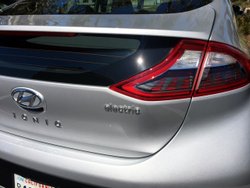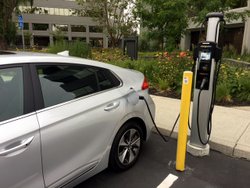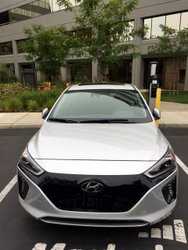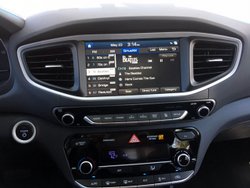One Model Tackles Two Markets
In the software business (and perhaps any company providing a product or service), there’s something called a “use case.” It helps define what the product or service is used for, and that assists in defining who the customer is. The new 2017 Hyundai Ioniq, then, is for two different personas.

Korean carmaker Hyundai has firmly established itself in the U.S. market by offering high-quality vehicles in many popular segments. With the all-new Ioniq line, the company fields a worthy rival for two of Clean Fleet Report’s favorite vehicle targets—electric cars and hybrids.
The first buyer is someone who has some concern for the environment, but wants to get in and drive with no fuss or limitation. The hybrid is perfect, because the 1.6-liter gas engine and 32 Kw electric motor automatically come on or off as conditions demand—and all the electricity gets regenerated by slowing down and braking. No need to ever plug in. The combined 139 horsepower moves the car along competently without undue drama or excitement.
The Second Use Case
The other use case the Ioniq addresses is the EV buyer. This person is more of an early adopter (although commercial electrics like the Leaf have been around since 2011). An EV is smooth, quiet and requires virtually no maintenance. Its great limitation is range. Although research shows that most people don’t drive near the 124 miles an Ioniq EV can go, we tend to want our cars to be ready for anything. That may relegate an electric car to “commuter” status, with a gas vehicle beside it on the driveway as backup for those longer trips. But this EV does everything you’d want and, with the greater torque inherent to electric motors, delivers a satisfying motoring experience.

Creating a new model is an expensive undertaking, so why not give it two purposes? The 2017 Hyundai Ioniq wears its copyright-protected, techy name on a good-looking midsize hatchback that manifests to the eye as a sedan. Perhaps its biggest achievement, besides top-market efficiency ratings, is that it is a more traditional-looking alternative than its targets.
So the 2017 Hyundai Ioniq comes as a hybrid or battery-powered all-electric car. A plug-in hybrid will fill out the line next year. This means that the new model is taking on the legendary Prius hybrid and a crop of EVs, led by the ground-breaking Nissan Leaf. The Ioniq EV, with its EPA-rated 124-mile range, competes directly with the latest model Leaf as well as the latest version of the Volkswagen e-Golf, BMW i3 and others. While it could be seen as an alternative to the new Chevrolet Bolt, the latter’s EPA 238-mile range is really the next-level.
A “Normal” Hybrid/EV
Hyundai has done a superb job of creating a comfortable, quiet, usable vehicle without the oddball proportions or styling excesses of Prius or Leaf. The face features a wide, tall mouth. The hybrid’s is a handsome grille, while the EV is smooth plastic—much like a Tesla minus the pucker. The proportions are somewhat Prius-like, presumably for aerodynamic benefits, and the rear window is split horizontally just like a Prius. The capacious hatchback provides the same level of usability of the Prius and Leaf. I found carrying musical gear around it has the space, although the rear liftover is a bit high.

Inside, there’s nothing wacky. A traditional instrument panel displays the information you need. Both cars provide a gauge to see if your battery is being charged or used, and you’re encouraged to drive efficiently. The EV also features the essential range indicator.
The seats look and feel fine; materials are high-quality, if just short of luxurious. I preferred the airier beige of my hybrid tester over the black in my EV sample, but both are nicely rendered.
The Numbers
The 2017 Hyundai Ioniq hybrid earns a stellar 55 mpg city/54 highway/55 combined. I averaged 46.8 mpg, but that’s still excellent. EPA green numbers are 8 for Smog (there is a gas engine in there, after all), and a perfect 10 for Greenhouse Gas. The 163 grams of CO2 per mile is less than half that of a normal midsize gasoline-only vehicle.
If a hybrid is all about maximizing miles per gallon, the EV goal is efficiency. The Ioniq EV gets a laudable 136 MPGe Combined rating (150 city/122 highway), very big numbers indeed. The latest Leaf earns 124 MPGe, for comparison. The Green scores for the Ioniq EV are perfect 10s, as expected. The environmental impact of an electric car depends on where and how the electricity was generated and the associated byproducts of its materials (including its expensive lithium-ion battery) and construction.

Both my Black Noir Pearl hybrid and Symphony Air Silver EV were Limited models, and both came with their respective “Ultimate Package.” That makes them top-of-the-line. Here’s where a buyer in the showroom has a decision to make as well. The hybrid listed at $31,460 while the EV came in at $36,835.
If history is a guide, the Hyundai Ioniq should be successful. With its attractive look, feature-packed models, and competitive pricing, Its two targets are not great volume sellers (yet), but these cars are aimed at the future. The plug-in hybrid that arrives soon will offer a third option between the two, with daily all-electric commuting and the freedom to drive anywhere for long trips—in one car. Stay tuned.
Related Stories You Might Enjoy:
Road Test: 2016 Toyota Prius (Larry’s view)
Road Test: 2016 Toyota Prius (Steve’s view)
Road Test: 2016 Nissan Leaf (Michael’s view)
Road Test: 2016 Nissan Leaf (John’s view)
Disclosure:
Clean Fleet Report is loaned free test vehicles from automakers to evaluate, typically for a week at a time. Our road tests are based on this one-week drive of a new vehicle. Because of this we don’t address issues such as long-term reliability or total cost of ownership. In addition we are often invited to manufacturer events highlighting new vehicles or technology. As part of these events we may be offered free transportation, lodging or meals. We do our best to present our unvarnished evaluations of vehicles and news irrespective of these inducements.
Our focus is on vehicles that offer the best fuel economy in their class, which leads us to emphasize electric cars, plug-in hybrids, hybrids and diesels. We also feature those efficient gas-powered vehicles that are among the top mpg vehicles in their class. In addition, we aim to offer reviews and news on advanced technology and the alternative fuel vehicle market. We welcome any feedback from vehicle owners and are dedicated to providing a forum for alternative viewpoints. Please let us know your views at publisher@cleanfleetreport.com.

6 thoughts on “Comparison Test: 2017 Hyundai Ioniq EV and Hybrid”